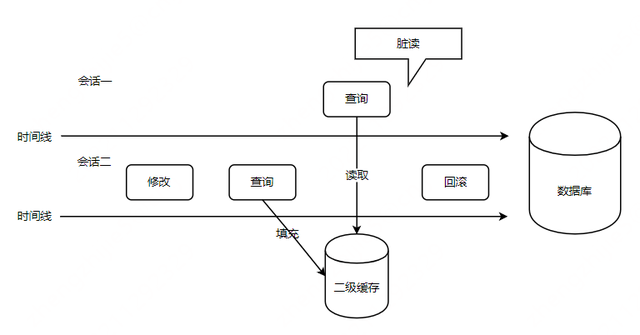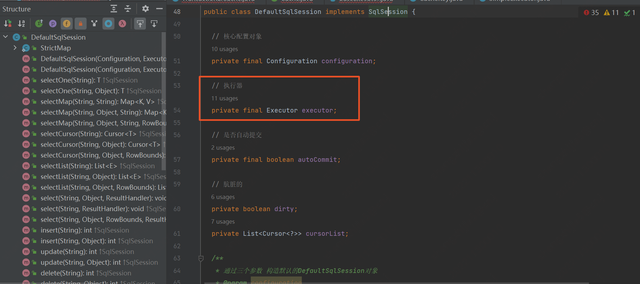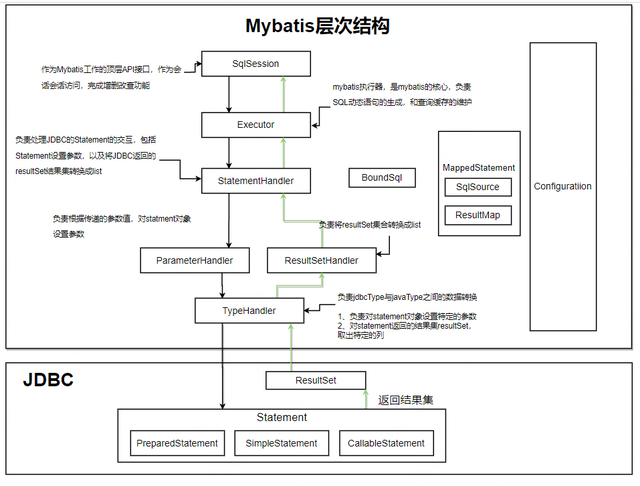作者:郑志杰
mybatis 操作数据库的过程
// 第一步:读取mybatis-config.xml配置文件
InputStream inputStream = Resources.getResourceAsStream("mybatis-config.xml");
// 第二步:构建SqlSessionFactory(框架初始化)
SqlSessionFactory sqlSessionFactory = new SqlSessionFactoryBuilder().bulid();
// 第三步:打开sqlSession
SqlSession session = sqlSessionFactory.openSession();
// 第四步:获取Mapper接口对象(底层是动态代理)
AccountMapper accountMapper = session.getMapper(AccountMapper.class);
// 第五步:调用Mapper接口对象的方法操作数据库;
Account account = accountMapper.selectByPrimaryKey(1);
通过调用 session.getMapper (AccountMapper.class) 所得到的 AccountMapper 是一个动态代理对象,所以执行
accountMapper.selectByPrimaryKey (1) 方法前,都会被 invoke () 拦截,先执行 invoke () 中的逻辑。
public Object invoke(Object proxy, Method method, Object[] args) throws Throwable {
try {
// 要执行的方法所在的类如果是Object,直接调用,不做拦截处理
if (Object.class.equals(method.getDeclaringClass())) {
return method.invoke(this, args);
//如果是默认方法,也就是java8中的default方法
} else if (isDefaultMethod(method)) {
// 直接执行default方法
return invokeDefaultMethod(proxy, method, args);
}
} catch (Throwable t) {
throw ExceptionUtil.unwrapThrowable(t);
}
// 从缓存中获取MapperMethod
final MapperMethod mapperMethod = cachedMapperMethod(method);
return mapperMethod.execute(sqlSession, args);
}
从 methodCache 获取对应 DAO 方法的 MapperMethod
MapperMethod 的主要功能是执行 SQL 语句的相关操作,在初始化的时候会实例化两个对象:SqlCommand(Sql 命令)和 MethodSignature(方法签名)。
/**
* 根据Mapper接口类型、接口方法、核心配置对象 构造MapperMethod对象
* @param mapperInterface
* @param method
* @param config
*/
public MapperMethod(Class<?> mapperInterface, Method method, Configuration config) {
this.command = new SqlCommand(config, mapperInterface, method);
// 将Mapper接口中的数据库操作方法(如Account selectById(Integer id);)封装成方法签名MethodSignature
this.method = new MethodSignature(config, mapperInterface, method);
}
new SqlCommand()调用 SqlCommand 类构造方法:
public SqlCommand(Configuration configuration, Class<?> mapperInterface, Method method) {
// 获取Mapper接口中要执行的某个方法的方法名
// 如accountMapper.selectByPrimaryKey(1)
final String methodName = method.getName();
// 获取方法所在的类
final Class<?> declaringClass = method.getDeclaringClass();
// 解析得到Mapper语句对象(对配置文件中的<mapper></mapper>中的sql语句进行封装)
MappedStatement ms = resolveMappedStatement(mapperInterface, methodName, declaringClass,
configuration);
if (ms == null) {
if (method.getAnnotation(Flush.class) != null) {
name = null;
type = SqlCommandType.FLUSH;
} else {
throw new BindingException("Invalid bound statement (not found): "
+ mapperInterface.getName() + "." + methodName);
}
} else {
// 如com.bjpowernode.mapper.AccountMapper.selectByPrimaryKey
name = ms.getId();
// SQL类型:增 删 改 查
type = ms.getSqlCommandType();
if (type == SqlCommandType.UNKNOWN) {
throw new BindingException("Unknown execution method for: " + name);
}
}
}
private MapperMethod cachedMapperMethod(Method method) {
MapperMethod mapperMethod = (MapperMethod)this.methodCache.get(method);
if (mapperMethod == null) {
mapperMethod = new MapperMethod(this.mapperInterface, method, this.sqlSession.getConfiguration());
this.methodCache.put(method, mapperMethod);
}
return mapperMethod;
}
调用 mapperMethod.execute (sqlSession, args)
在 mapperMethod.execute () 方法中,我们可以看到:mybatis 定义了 5 种 SQL 操作类型:
insert/update/delete/select/flush。其中,select 操作类型又可以分为五类,这五类的返回结果都不同,分别对应:
・返回参数为空:executeWithResultHandler ();
・查询多条记录:executeForMany (),返回对象为 JavaBean
・返参对象为 map:executeForMap (), 通过该方法查询数据库,最终的返回结果不是 JavaBean,而是 Map
・游标查询:executeForCursor ();关于什么是游标查询,自行百度哈;
・查询单条记录: sqlSession.selectOne (),通过该查询方法,最终只会返回一条结果;
通过源码追踪我们可以不难发现:当调用 mapperMethod.execute () 执行 SQL 语句的时候,无论是
insert/update/delete/flush,还是 select(包括 5 种不同的 select), 本质上时通过 sqlSession 调用的。在 SELECT 操作中,虽然调用了 MapperMethod 中的方法,但本质上仍是通过 Sqlsession 下的 select (), selectList (), selectCursor (), selectMap () 等方法实现的。
而 SqlSession 的内部实现,最终是调用执行器 Executor(后面会细说)。这里,我们可以先大概看一下 mybatis 在执行 SQL 语句的时候的调用过程:

以accountMapper.selectByPrimaryKey (1) 为例:
・调用 SqlSession.getMapper ():得到 xxxMapper (如 UserMapper) 的动态代理对象;
・调用
accountMapper.selectByPrimaryKey (1):在 xxxMapper 动态代理内部,会根据要执行的 SQL 语句类型 (insert/update/delete/select/flush) 来调用 SqlSession 对应的不同方法,如 sqlSession.insert ();
・在 sqlSession.insert () 方法的实现逻辑中,又会转交给 executor.query () 进行查询;
・executor.query () 又最终会转交给 statement 类进行操作,到这里就是 jdbc 操作了。
有人会好奇,为什么要通过不断的转交,SqlSession->Executor->Statement,而不是直接调用 Statement 执行 SQL 语句呢?因为在调用 Statement 之前,会处理一些共性的逻辑,如在 Executor 的实现类 BaseExecutor 会有一级缓存相关的逻辑,在 CachingExecutor 中会有二级缓存的相关逻辑。如果直接调用 Statement 执行 SQL 语句,那么在每个 Statement 的实现类中,都要写一套一级缓存和二级缓存的逻辑,就显得冗余了。这一块后面会细讲。
// SQL命令(在解析mybatis-config.xml配置文件的时候生成的)
private final SqlCommand command;
public Object execute(SqlSession sqlSession, Object[] args) {
Object result;
// 从command对象中获取要执行操作的SQL语句的类型,如INSERT/UPDATE/DELETE/SELECT
switch (command.getType()) {
// 插入
case INSERT: {
// 把接口方法里的参数转换成sql能识别的参数
// 如:accountMapper.selectByPrimaryKey(1)
// 把其中的参数"1"转化为sql能够识别的参数
Object param = method.convertArgsToSqlCommandParam(args);
// sqlSession.insert(): 调用SqlSession执行插入操作
// rowCountResult(): 获取SQL语句的执行结果
result = rowCountResult(sqlSession.insert(command.getName(), param));
break;
}
// 更新
case UPDATE: {
Object param = method.convertArgsToSqlCommandParam(args);
// sqlSession.insert(): 调用SqlSession执行更新操作
// rowCountResult(): 获取SQL语句的执行结果
result = rowCountResult(sqlSession.update(command.getName(), param));
break;
}
// 删除
case DELETE: {
Object param = method.convertArgsToSqlCommandParam(args);
// sqlSession.insert(): 调用SqlSession执行更新操作
// rowCountResult(): 获取SQL语句的执行结果
result = rowCountResult(sqlSession.delete(command.getName(), param));
break;
}
// 查询
case SELECT:
// method.returnsVoid(): 返参是否为void
// method.hasResultHandler(): 是否有对应的结果处理器
if (method.returnsVoid() && method.hasResultHandler()) {
executeWithResultHandler(sqlSession, args);
result = null;
} else if (method.returnsMany()) { // 查询多条记录
result = executeForMany(sqlSession, args);
} else if (method.returnsMap()) { // 查询结果返参为Map
result = executeForMap(sqlSession, args);
} else if (method.returnsCursor()) { // 以游标的方式进行查询
result = executeForCursor(sqlSession, args);
} else {
// 参数转换 转成sqlCommand参数
Object param = method.convertArgsToSqlCommandParam(args);
// 执行查询 查询单条数据
result = sqlSession.selectOne(command.getName(), param);
if (method.returnsOptional()
&& (result == null || !method.getReturnType().equals(result.getClass()))) {
result = Optional.ofNullable(result);
}
}
break;
case FLUSH: // 执行清除操作
result = sqlSession.flushStatements();
break;
default:
throw new BindingException("Unknown execution method for: " + command.getName());
}
if (result == null && method.getReturnType().isPrimitive() && !method.returnsVoid()) {
throw new BindingException("Mapper method '" + command.getName()
+ " attempted to return null from a method with a primitive return type (" + method.getReturnType() + ").");
}
return result;
}
在上面,有多处出现这样一行代码:
method.convertArgsToSqlCommandParam (args),该方法的作用就是将方法参数转换为 SqlCommandParam;具体交由
paramNameResolver.getNamedParams () 实现。在看 paramNameResolver.getNamedParams () 之前,我们先来看下 paramNameResolver 是什么东西?
public Object convertArgsToSqlCommandParam(Object[] args) {
return paramNameResolver.getNamedParams(args);
}
在前面,我们在实例化 MethodSignature 对象 (new MethodSignature) 的时候,在其构造方法中,会实例化 ParamNameResolver 对象,该对象主要用来处理接口形式的参数,最后会把参数处放在一个 map(即属性 names)中。map 的 key 为参数的位置,value 为参数的名字。
public MethodSignature(Configuration configuration, Class<?> mapperInterface, Method method) {
...
this.paramNameResolver = new ParamNameResolver(configuration, method);
}
对 names 字段的解释:
假设在 xxxMapper 中有这么一个接口方法 selectByIdAndName ()
・selectByIdAndName (@Param ("id") String id, @Param ("name") String name) 转化为 map 为 {{0, "id"}, {1, "name"}}
・selectByIdAndName (String id, String name) 转化为 map 为 {{0, "0"}, {1, "1"}}
・selectByIdAndName (int a, RowBounds rb, int b) 转化为 map 为 {{0, "0"}, {2, "1"}}
构造方法的会经历如下的步骤
1. 通过反射得到方法的参数类型和方法的参数注解注解,
method.getParameterAnnotations () 方法返回的是注解的二维数组,每一个方法的参数包含一个注解数组。
2. 遍历所有的参数
- 首先判断这个参数的类型是否是特殊类型,RowBounds 和 ResultHandler,是的话跳过,咱不处理
- 判断这个参数是否是用来 Param 注解,如果使用的话 name 就是 Param 注解的值,并把 name 放到 map 中,键为参数在方法中的位置,value 为 Param 的值
- 如果没有使用 Param 注解,判断是否开启了 UseActualParamName,如果开启了,则使用 java8 的反射得到方法的名字,此处容易造成异常,
具体原因参考上一篇博文.
- 如果以上条件都不满足的话,则这个参数的名字为参数的下标
// 通用key前缀,因为key有param1,param2,param3等;
public static final String GENERIC_NAME_PREFIX = "param";
// 存放参数的位置和对应的参数名
private final SortedMap<Integer, String> names;
// 是否使用@Param注解
private boolean hasParamAnnotation;
public ParamNameResolver(Configuration config, Method method) {
// 通过注解得到方法的参数类型数组
final Class<?>[] paramTypes = method.getParameterTypes();
// 通过反射得到方法的参数注解数组
final Annotation[][] paramAnnotations = method.getParameterAnnotations();
// 用于存储所有参数名的SortedMap对象
final SortedMap<Integer, String> map = new TreeMap<>();
// 参数注解数组长度,即方法入参中有几个地方使用了@Param
// 如selectByIdAndName(@Param("id") String id, @Param("name") String name)中,paramCount=2
int paramCount = paramAnnotations.length;
// 遍历所有的参数
for (int paramIndex = 0; paramIndex < paramCount; paramIndex++) {
// 判断这个参数的类型是否是特殊类型,RowBounds和ResultHandler,是的话跳过
if (isSpecialParameter(paramTypes[paramIndex])) {
continue;
}
String name = null;
for (Annotation annotation : paramAnnotations[paramIndex]) {
// 判断这个参数是否使用了@Param注解
if (annotation instanceof Param) {
// 标记当前方法使用了Param注解
hasParamAnnotation = true;
// 如果使用的话name就是Param注解的值
name = ((Param) annotation).value();
break;
}
}
// 如果经过上面处理,参数名还是null,则说明当前参数没有指定@Param注解
if (name == null) {
// 判断是否开启了UseActualParamName
if (config.isUseActualParamName()) {
// 如果开启了,则使用java8的反射得到该参数对应的属性名
name = getActualParamName(method, paramIndex);
}
// 如果name还是为null
if (name == null) {
// use the parameter index as the name ("0", "1", ...)
// 使用参数在map中的下标作为参数的name,如 ("0", "1", ...)
name = String.valueOf(map.size());
}
}
// 把参数放入到map中,key为参数在方法中的位置,value为参数的name(@Param的value值/参数对应的属性名/参数在map中的位置下标)
map.put(paramIndex, name);
}
// 最后使用Collections工具类的静态方法将结果map变为一个不可修改类型
names = Collections.unmodifiableSortedMap(map);
}
getNamedParams(): 该方法会将参数名和参数值对应起来,并且还会额外保存一份以 param 开头加参数顺序数字的值
public Object getNamedParams(Object[] args) {
// 这里的names就是ParamNameResolver中的names,在构造ParamNameResolver对象的时候,创建了该Map
// 获取方法参数个数
final int paramCount = names.size();
// 没有参数
if (args == null || paramCount == 0) {
return null;
// 只有一个参数,并且没有使用@Param注解。
} else if (!hasParamAnnotation && paramCount == 1) {
// 直接返回,不做任务处理
return args[names.firstKey()];
} else {
// 包装成ParamMap对象。这个对象继承了HashMap,重写了get方法。
final Map<String, Object> param = new ParamMap<>();
int i = 0;
// 遍历names中的所有键值对
for (Map.Entry<Integer, String> entry : names.entrySet()) {
// 将参数名作为key, 对应的参数值作为value,放入结果param对象中
param.put(entry.getValue(), args[entry.getKey()]);
// 用于添加通用的参数名称,按顺序命名(param1, param2, ...)
final String genericParamName = GENERIC_NAME_PREFIX + (i + 1);
// 确保不覆盖以@Param 命名的参数
if (!names.containsValue(genericParamName)) {
param.put(genericParamName, args[entry.getKey()]);
}
i++;
}
return param;
}
}
}
getNamedParams () 总结:
1. 当只有一个参数的时候,直接返回,不做任务处理;
2. 否则,存入 Map 中,键值对形式为:paramName=paramValue
・selectByIdAndName (@Param ("id") String id, @Param ("name") String name): 传入的参数是 ["1", "张三"],最后解析出来的 map 为:{“id”:”1”,”“name”:” 张三”}
・selectByIdAndName (String id, @Param ("name") String name): 传入的参数是 ["1", "张三"],最后解析出来的 map 为:{“param1”:”1”,”“name”:” 张三”}
假设执行的 SQL 语句是 select 类型,继续往下看代码
在 mapperMethod.execute (), 当
convertArgsToSqlCommandParam () 方法处理完方法参数后,假设我们此时调用的是查询单条记录,那么接下来会执行 sqlSession.selectOne () 方法。
sqlSession.selectOne () 源码分析:
sqlSession.selectOne () 也是调的 sqlSession.selectList () 方法,只不过只返回 list 中的第一条数据。当 list 中有多条数据时,抛异常。
@Override
public <T> T selectOne(String statement, Object parameter) {
// 调用当前类的selectList方法
List<T> list = this.selectList(statement, parameter);
if (list.size() == 1) {
return list.get(0);
} else if (list.size() > 1) {
throw new TooManyResultsException("Expected one result (or null) to be returned by selectOne(), but found: " + list.size());
} else {
return null;
}
}
sqlSession.selectList () 方法
@Override
public <E> List<E> selectList(String statement, Object parameter) {
return this.selectList(statement, parameter, RowBounds.DEFAULT);
}
继续看:
@Override
public <E> List<E> selectList(String statement, Object parameter, RowBounds rowBounds) {
try {
// 从Configuration里的mappedStatements里根据key(id的全路径)获取MappedStatement对象
MappedStatement ms = configuration.getMappedStatement(statement);
// 调用Executor的实现类BaseExecutor的query()方法
return executor.query(ms, wrapCollection(parameter), rowBounds, Executor.NO_RESULT_HANDLER);
} catch (Exception e) {
throw ExceptionFactory.wrapException("Error querying database. Cause: " + e, e);
} finally {
ErrorContext.instance().reset();
}
}
在 sqlSession.selectList () 方法中,我们可以看到调用了 executor.query (),假设我们开启了二级缓存,那么 executor.query () 调用的是 executor 的实现类 CachingExecutor 中的 query (),二级缓存的逻辑就是在 CachingExecutor 这个类中实现的。
关于 mybatis 二级缓存:
二级缓存默认是不开启的,需要手动开启二级缓存,实现二级缓存的时候,MyBatis 要求返回的 POJO 必须是可序列化的。缓存中存储的是序列化之后的,所以不同的会话操作对象不会改变缓存。
怎么开启二级缓存:
<settings>
<setting name = "cacheEnabled" value = "true" />
</settings>
怎么使用二级缓存?
1. 首先肯定是要开启二级缓存啦~
2. 除此之外,要使用二级缓存还要满足以下条件:
・当会话提交之后才会填充二级缓存(为什么?后面会解释)
・SQL 语句相同,参数相同
・相同的 statementID
・RowBounds 相同
为什么要会话提交后才会填充二级缓存?
首先,我们知道,与一级缓存(会话级缓存)不同的是,二级缓存是跨线程使用的,也就是多个会话可以一起使用同一个二级缓存。假设现在不用提交便可以填充二级缓存,我们看看会存在什么问题?
假设会话二现在对数据库进行了修改操作,修改完进行了查询操纵,如果不用提交就会填充二级缓存的话,这时候查询操作会把刚才修改的数据填充到二级缓存中,如果此时刚好会话一执行了查询操作,便会查询到二级缓存中的数据。如果会话二最终回滚了刚才的修改操作,那么会话一就相当于发生了脏读。

实际上,查询的时候会填充缓存,只不过此时是填充在暂存区,而不是填充在真正的二级缓存区中。而上面所说的要会话提交后才会填充二级缓存,指的是将暂存区中的缓存刷到真正的二级缓存中。啊???那不对呀,填充在暂存区,那此时会话一来查询,岂不是还会从暂存区中取到缓存,从而导致脏读?别急,接着往下看。
对于查询操作,每次取缓存都是从真正的二级缓存中取缓存,而不是从暂存区中取缓存。
好了,我们接着看源码~
CachingExecutor.query () 源码:
@Override
public <E> List<E> query(MappedStatement ms, Object parameterObject, RowBounds rowBounds, ResultHandler resultHandler) throws SQLException {
// 获取要执行的sql语句 sql语句在解析xml的时候就已经解析好了
BoundSql boundSql = ms.getBoundSql(parameterObject);
// 生成二级缓存key
CacheKey key = createCacheKey(ms, parameterObject, rowBounds, boundSql);
// 调用重载方法
return query(ms, parameterObject, rowBounds, resultHandler, key, boundSql);
}
调用重载方法:query ()
@Override
public <E> List<E> query(MappedStatement ms, Object parameterObject, RowBounds rowBounds, ResultHandler resultHandler, CacheKey key, BoundSql boundSql)
throws SQLException {
// 获取mybatis的二级缓存配置<cache>
Cache cache = ms.getCache();
// 如果配置了二级缓存
if (cache != null) {
// 是否要刷新缓存,是否手动设置了需要清空缓存
flushCacheIfRequired(ms);
if (ms.isUseCache() && resultHandler == null) {
ensureNoOutParams(ms, boundSql);
@SuppressWarnings("unchecked")
// 从二级缓存中获取值
List<E> list = (List<E>) tcm.getObject(cache, key);
// 从二级缓存中取不到值
if (list == null) {
// 交由delegate查询 这里的delegate指向的是BaseExecutor
// BaseExecutor中实现了一级缓存的相关逻辑
// 也就是说,当在二级缓存中获取不到值的时候,会从一级缓存中获取,一级缓存要是还是获取不到
// 才会去查询数据库
list = delegate.query(ms, parameterObject, rowBounds, resultHandler, key, boundSql);
// 将查询结果存放在暂存区中,只有会话提交后才会将数据刷到二级缓存,避免脏读问题
tcm.putObject(cache, key, list); // issue #578 and #116
}
return list;
}
}
return delegate.query(ms, parameterObject, rowBounds, resultHandler, key, boundSql);
}
接着,我们看下 BaseExecutor.query () 是怎么实现一级缓存逻辑的:
@SuppressWarnings("unchecked")
@Override
public <E> List<E> query(MappedStatement ms, Object parameter, RowBounds rowBounds, ResultHandler resultHandler, CacheKey key, BoundSql boundSql) throws SQLException {
ErrorContext.instance().resource(ms.getResource()).activity("executing a query").object(ms.getId());
if (closed) {
throw new ExecutorException("Executor was closed.");
}
if (queryStack == 0 && ms.isFlushCacheRequired()) {
clearLocalCache();
}
List<E> list;
try {
queryStack++;
// 尝试从缓存中获取结果 一级缓存
list = resultHandler == null ? (List<E>) localCache.getObject(key) : null;
if (list != null) {
handleLocallyCachedOutputParameters(ms, key, parameter, boundSql);
} else {// 从缓存中获取不到结果时
// 从数据库中查询数据
list = queryFromDatabase(ms, parameter, rowBounds, resultHandler, key, boundSql);
}
} finally {
queryStack--;
}
if (queryStack == 0) { // 回到主查询
// 遍历延迟加载中的数据
for (DeferredLoad deferredLoad : deferredLoads) {
// 把延迟加载的数据加载到结果集中
deferredLoad.load();
}
// issue #601
deferredLoads.clear();
if (configuration.getLocalCacheScope() == LocalCacheScope.STATEMENT) {
// issue #482
clearLocalCache();
}
}
return list;
}
当从一级缓存中获取不到数据时,会查数据库:
调用
BaseExecutor.queryFromDatabase()
private <E> List<E> queryFromDatabase(MappedStatement ms, Object parameter, RowBounds rowBounds, ResultHandler resultHandler, CacheKey key, BoundSql boundSql) throws SQLException {
List<E> list;
// 占位符 (解决循环依赖问题)
localCache.putObject(key, EXECUTION_PLACEHOLDER);
try {
// 执行查询操作
list = doQuery(ms, parameter, rowBounds, resultHandler, boundSql);
} finally {
// 将占位符从缓存中移除
localCache.removeObject(key);
}
// 将查询结果放入到一级缓存中
localCache.putObject(key, list);
if (ms.getStatementType() == StatementType.CALLABLE) {
localOutputParameterCache.putObject(key, parameter);
}
return list;
}
调用 BaseExecutor.doQuery ():在 BaseExecutor 中,doQuery () 只是个抽象方法,具体交由子类实现:
protected abstract <E> List<E> doQuery(MappedStatement ms, Object parameter, RowBounds rowBounds, ResultHandler resultHandler, BoundSql boundSql)
throws SQLException;
从前面的流程中可知,在每次执行 CURD 的时候,都需要获取 SqlSession 这个对象,接口如下:
可以看出来这个接口主要定义类关于 CRUD、数据库事务、数据库刷新等相关操作。下面看它的默认实现类:

可以看到 DefaultSqlSession 实现了 SqlSession 中的方法,(其实我们自己也可根据需要去实现)。而在 DefaultSqlSession 类中有一个很重要的属性,就是 Mybatis 的执行器(Executor)。
Executor 介绍:
Executor 执行器,是 mybatis 中执行查询的主要代码,Executor 分为三种:
・简单执行器 SimpleExecutor
・可重用执行器 ReuseExecutor
・批量执行器 BatchExecutor
默认使用的执行器是 SimpleExecutor,可以在 mybatis 的配置文件中设置使用哪种执行器
public class Configuration {
protected ExecutorType defaultExecutorType = ExecutorType.SIMPLE;
}
Executor 类图:

假设我们使用的就是默认的执行器,SimpleExecutor。我们来看下 SimpleExecutor.doQuery ()
@Override
public <E> List<E> doQuery(MappedStatement ms, Object parameter, RowBounds rowBounds, ResultHandler resultHandler, BoundSql boundSql) throws SQLException {
// 这里就进入jdbc了
Statement stmt = null;
try {
// 获取核心配置对象
Configuration configuration = ms.getConfiguration();
StatementHandler handler = configuration.newStatementHandler(wrapper, ms, parameter, rowBounds, resultHandler, boundSql);
//预编译SQL语句
stmt = prepareStatement(handler, ms.getStatementLog());
// 执行查询
return handler.query(stmt, resultHandler);
} finally {
closeStatement(stmt);
}
}
private Statement prepareStatement(StatementHandler handler, Log statementLog) throws SQLException {
Statement stmt;
// 获取连接 这里的连接是代理连接
Connection connection = getConnection(statementLog);
// 预编译
stmt = handler.prepare(connection, transaction.getTimeout());
// 给预编译sql语句设置参数
handler.parameterize(stmt);
return stmt;
}
在上面的源码中,我们可以看到 StatementHandler,它是用来干嘛的?
在 mybatis 中,通过 StatementHandler 来处理与 JDBC 的交互,我们看下 StatementHandler 的类图:

可以看出,跟 Executor 的继承实现很像,都有一个 Base,Base 下面又有几个具体实现子类,很明显,采用了模板模式。不同于 CacheExecutor 用于二级缓存之类的实际作用,这里的 RoutingStatementHandler 仅用于维护三个 Base 子类的创建与调用。
•BaseStatementHandler
・SimpleStatementHandler:JDBC 中的 Statement 接口,处理简单 SQL 的
・CallableStatementHandler:JDBC 中的 PreparedStatement,预编译 SQL 的接口
・PreparedStatementHandler:JDBC 中的 CallableStatement,用于执行存储过程相关的接口
・RoutingStatementHandler:路由三个 Base 子类,负责其创建及调用
public RoutingStatementHandler(Executor executor, MappedStatement ms, Object parameter, RowBounds rowBounds, ResultHandler resultHandler, BoundSql boundSql) {
switch (ms.getStatementType()) {
// 策略模式:根据不同语句类型 选用不同的策略实现类
case STATEMENT:
delegate = new SimpleStatementHandler(executor, ms, parameter, rowBounds, resultHandler, boundSql);
break;
case PREPARED:
delegate = new PreparedStatementHandler(executor, ms, parameter, rowBounds, resultHandler, boundSql);
break;
case CALLABLE:
delegate = new CallableStatementHandler(executor, ms, parameter, rowBounds, resultHandler, boundSql);
break;
default:
throw new ExecutorException("Unknown statement type: " + ms.getStatementType());
}
}
嗯,很眼熟的策略模式,按照 statementType 的值来决定返回哪种 StatementHandler。
那这里的 statementType 是在哪里赋值的呢?我们看下 MappedStatement 的构造方法:
public Builder(Configuration configuration, String id, SqlSource sqlSource, SqlCommandType sqlCommandType) {
...
// 构造方法中默认取值为PREPARED
mappedStatement.statementType = StatementType.PREPARED;
...
}
如果不想使用的 StatementType.PREPARED,怎么自定义呢?
(1) 在 xxxMapper.xml 中:可以通过 <select /> 的 statementType 属性指定
<select id="getAll" resultType="Student2" statementType="CALLABLE">
SELECT * FROM Student
</select>
(2) 如果采用的是注解开发:通过 @SelectKey 的 statementType 属性指定
@SelectKey(keyProperty = "account",
before = false,
statementType = StatementType.STATEMENT,
statement = "select * from account where id = #{id}",
resultType = Account.class)
Account selectByPrimaryKey(@Param("id") Integer id);
到此,select 类型的 SQL 语句就基本执行完毕了,我们来总结一下 mybatis
MyBatis 的主要的核心部件有以下几个:
SqlSession:作为 MyBatis 工作的主要顶层 API,表示和数据库交互的会话,完成必要数据库增删改查功能;
Executor:MyBatis 执行器,是 MyBatis 调度的核心,负责 SQL 语句的生成和查询缓存的维护;
StatementHandler:封装了 JDBC Statement 操作,负责对 JDBC statement 的操作,如设置参数、将 Statement 结果集转换成 List 集合。
ParameterHandler:负责对用户传递的参数转换成 JDBC Statement 所需要的参数;
ResultSetHandler:负责将 JDBC 返回的 ResultSet 结果集对象转换成 List 类型的集合;
TypeHandler:负责 java 数据类型和 jdbc 数据类型之间的映射和转换;
MappedStatement:MappedStatement 维护了一条 <select|update|delete|insert> 节点的封装;
SqlSource:负责根据用户传递的 parameterObject,动态地生成 SQL 语句,将信息封装到 BoundSql 对象中,并返回;
BoundSql:表示动态生成的 SQL 语句以及相应的参数信息;
Configuration:MyBatis 所有的配置信息都维持在 Configuration 对象之中;

 标签:name,sqlSession,二级缓存,源码,参数,ms,SQL,Mybatis,method
From: https://www.cnblogs.com/Jcloud/p/16977916.html
标签:name,sqlSession,二级缓存,源码,参数,ms,SQL,Mybatis,method
From: https://www.cnblogs.com/Jcloud/p/16977916.html